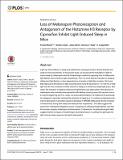| dc.contributor.author | Muindi, Fanuel | |
| dc.contributor.author | Colas, Damien | |
| dc.contributor.author | Ikeme, Jesse | |
| dc.contributor.author | Ruby, Norman F. | |
| dc.contributor.author | Heller, H. Craig | |
| dc.date.accessioned | 2015-08-20T18:21:40Z | |
| dc.date.available | 2015-08-20T18:21:40Z | |
| dc.date.issued | 2015-06 | |
| dc.date.submitted | 2015-01 | |
| dc.identifier.issn | 1932-6203 | |
| dc.identifier.uri | http://hdl.handle.net/1721.1/98135 | |
| dc.description.abstract | Light has direct effects on sleep and wakefulness causing arousal in diurnal animals and sleep in nocturnal animals. In the present study, we assessed the modulation of light-induced sleep by melanopsin and the histaminergic system by exposing mice to millisecond light flashes and continuous light respectively. First, we show that the induction of sleep by millisecond light flashes is dose dependent as a function of light flash number. We found that exposure to 60 flashes of light occurring once every 60 seconds for 1-h (120-ms of total light over an hour) induced a similar amount of sleep as a continuous bright light pulse. Secondly, the induction of sleep by millisecond light flashes was attenuated in the absence of melanopsin when animals were presented with flashes occurring every 60 seconds over a 3-h period beginning at ZT13. Lastly, the acute administration of a histamine H3 autoreceptor antagonist, ciproxifan, blocked the induction of sleep by a 1-h continuous light pulse during the dark period. Ciproxifan caused a decrease in NREMS delta power and an increase in theta activity during both sleep and wake periods respectively. The data suggest that some form of temporal integration occurs in response to millisecond light flashes, and that this process requires melanopsin photoreception. Furthermore, the pharmacological data suggest that the increase of histaminergic neurotransmission is sufficient to attenuate the light-induced sleep response during the dark period. | en_US |
| dc.description.sponsorship | Down Syndrome Research and Treatment Foundation | en_US |
| dc.description.sponsorship | Research Down Syndrome Organization | en_US |
| dc.language.iso | en_US | |
| dc.publisher | Public Library of Science | en_US |
| dc.relation.isversionof | http://dx.doi.org/10.1371/journal.pone.0128175 | en_US |
| dc.rights | Creative Commons Attribution | en_US |
| dc.rights.uri | http://creativecommons.org/licenses/by/4.0/ | en_US |
| dc.source | Public Library of Science | en_US |
| dc.title | Loss of Melanopsin Photoreception and Antagonism of the Histamine H3 Receptor by Ciproxifan Inhibit Light-Induced Sleep in Mice | en_US |
| dc.type | Article | en_US |
| dc.identifier.citation | Muindi, Fanuel, Damien Colas, Jesse Ikeme, Norman F. Ruby, and H. Craig Heller. “Loss of Melanopsin Photoreception and Antagonism of the Histamine H3 Receptor by Ciproxifan Inhibit Light-Induced Sleep in Mice.” Edited by Henrik Oster. PLoS ONE 10, no. 6 (June 17, 2015): e0128175. | en_US |
| dc.contributor.department | Massachusetts Institute of Technology. Department of Brain and Cognitive Sciences | en_US |
| dc.contributor.mitauthor | Muindi, Fanuel | en_US |
| dc.relation.journal | PLOS ONE | en_US |
| dc.eprint.version | Final published version | en_US |
| dc.type.uri | http://purl.org/eprint/type/JournalArticle | en_US |
| eprint.status | http://purl.org/eprint/status/PeerReviewed | en_US |
| dspace.orderedauthors | Muindi, Fanuel; Colas, Damien; Ikeme, Jesse; Ruby, Norman F.; Heller, H. Craig | en_US |
| dc.identifier.orcid | https://orcid.org/0000-0002-1998-1449 | |
| mit.license | PUBLISHER_CC | en_US |
| mit.metadata.status | Complete | |
